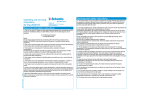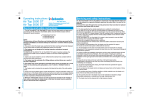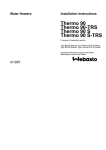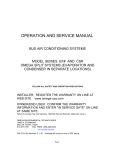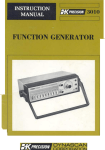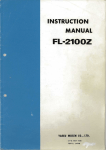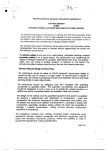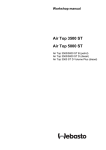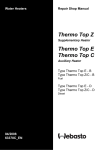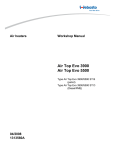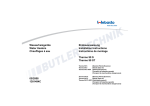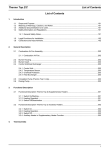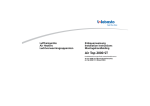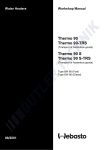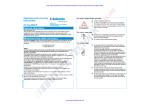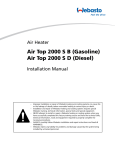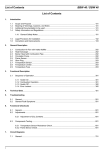Download Webastoto Air Top 5000 Technical data
Transcript
Air Heaters Installation instructions Air Top 3500 Air Top 5000 Type Air Top 3500 B (Petrol Type Air Top 3500 D (Diesel) Type Air Top 5000 B (Petrol) Type Air Top 5000 D (Diesel) 12/1998 Air Top 3500/5000 Table of Contents Page Installation Instructions Legal Provisions for Installation Installation Installation Example Heating Air System Fuel Supply Combustion Air Supply Exhaust Pipe Electrical Connections Circuit Diagrams Initial Operation Shut-Down on Faults Technical Data Drilling Template Webasto Service Phone II 1 3 5 6 7 10 10 12 15 22 22 23 25 27 Air Top 3500/5000 Installation Instructions Legal Provisions for Installation For testing the heater in accordance with §§ 19, 20 or 21 StVZO (German Road Licensing Regulations) the following regulations are primarily to be observed (§ 22 a StVZO): NOTE: These provisions are binding within the scope of the StVZO and should also be observed in countries where no special regulations are in effect! Within the scope of the StVZO (German Road Licensing Regulations) “General Design Certifications” have been granted by the Federal Office for Motor Traffic for the Air Top 3500/5000 air heaters with the following design approval numbers: ~ S 305 Air Top 3500 B ~ S 306 Air Top 3500 D ~ S 304 Air Top 5000 B ~ S 303 Air Top 5000 D The installation of the heaters must be performed in accordance with these Installation Instructions. The installation must be checked a) upon the homologation of the vehicles in accordance with § 20 StVZO b) upon any individual test in accordance with § 21 StVZO, or c) upon any examination in accordance with § 19 StVZO by a registered expert or examiner for motor traffic, an expert for automotive vehicles, or any other authorised official, in accordance with paragraph 7.4 a of Appendix VIII to the StVZO and in the case of item c) the proper installation must be certified on the approval certificate contained on the design certification stating the following: - vehicle manufacturer - vehicle type and - vehicle identification number The effectiveness of the design certification (homologation) is dependent on this certificate. The approval certification is to be kept in the vehicle. Extracting the combustion air from the interior of the vehicle is not permissible. “Combustion air pipe: The combustion air required The year of the initial operation must be durably marked on the type plate of the heater by the installer by removing the years that do not apply. The heat exchanger of the air heater is not to be used for longer than ten years and must thereafter be replaced by the manufacturer or one of its authorised dealers with a genuine replacement part. If exhaust pipes lead through passenger areas, these pipes must also be replaced with genuine replacement parts after ten years. Whenever the heater is removed it is imperative that the gasket located underneath be replaced. must be drawn in from the outside of the vehicle. Inside passenger areas the combustion air lines are permitted to have a maximum of four joints and must be provided with a splash-proof opening leading through the outside wall. These joints must be so sealed that a total leakage rate of 200 l/h at an overpressure of 0.5 mbar is not exceeded. The pipe including lead-through, joints, material and type of construction must be specified in the installation instructions. Mounting and removal of the pipe must be possible with tools only, the pipe must be protected against damage and be permanently vibration-proof. “Exhaust gas pipe”: The heaters must be so designed The heaters are approved for heating the passenger compartment and the driver’s cabin, not however, the cargo space for the transport of hazardous materials. When using the heater in special vehicles (e.g. “TRS” vehicles for the transport of hazardous materials) or in vehicles not subject to StVZO regulations (e.g. ships) all regulations that may be locally applicable are to be complied with. When installing the Air top 3500/5000 D heater in vehicles for the transport of hazardous materials the requirements laid down in TRS 002 and TRS 003 (Technical Guidelines relating to the ordinance of transporting hazardous materials on the road) must be fulfilled in addition to those of the StVZO. “Heating air system”:Heating air intake openings must be so arranged that the possibility of exhaust fumes from the vehicle engine and the heater being drawn in is remote under normal operating conditions. that the exhaust fumes are discharged to the atmosphere. Exhaust pipes must be so routed that the possibility of exhaust gases penetrating the interior of the vehicle is remote. The functioning of any parts of the vehicle essential for its operation must not be impaired. Any condensate or water that may have entered must not be able to collect in the exhaust gas line. Drain holes are permissible; these must discharge the liquid to the atmosphere via lines that are leakproof in relation to the interior of the vehicle. The discharge opening of the exhaust pipe is to point upward, sideways or, in the case of routing the exhaust pipes on the underside of the bottom of the vehicle, it must be positioned near the lateral or rear edge of the driver’s cab or vehicle. Inside areas where people are present, exhaust pipes may have a maximum of one joint, and their lead-through through the outer wall/bottom of the vehicle must be splash-proof. It is permissible to connect a drain pipe provided with a leak-proof metal joint to discharge the water penetrated into the exhaust pipe. The drain pipe is to be passed through the outside wall or the bottom of the ve- 1 Air Top 3500/5000 hicle through a sealed bush. The heat exchanger, the connected exhaust pipe as well as any drain pipe that may be connected must be so sealed that in the event of an overpressure equivalent to the twofold overpressure of the exhaust gas at maximum permissible exhaust pipe length – however, at a minimum overpressure of 0.5 mbar – a leakage rate of a total of 30 l/h is not exceeded. The pipe including lead-through, joints, material and type of construction must be specified in the installation instructions. Mounting and removal of the pipe must be possible with tools only, it must be protected against damage and be permanently vibration-proof. Only metal pipes may be used. These must not exceed a temperature of 110 °C if the possibility of accidental contact in the vehicle’s interior exists. It is permissible to install a protection against accidental contact. “Combustion Air Inlet” and “Exhaust Gas Outlet”: During installation it must be ensured that the openings of the combustion air inlet and exhaust gas outlet pipes are so designed that a spherical object of 16 mm diameter cannot be introduced. Electric lines, switchgear and controlgear of the heater must be so arranged in the vehicle that their functioning cannot be impaired under normal operating conditions. All tubes leading from the heater toward the outside must be routed through splashwater-proof openings. In the case of buses, the heater must be installed neither in the driver’s compartment nor in the passenger area. For the routing of fuel lines and the installation of additional fuel tanks, articles 45 and 46 StVZO are to be adhered to. The most important excerpts therefrom are as follows: Fuel lines are to be designed in such a way that their stability remains unaffected by torsional stresses in the vehicle, engine movement and the like. They must be protected against mechanical damage. All parts of the fuel system must be protected against heat which would impair 2 their operation, and must be located such that dripping or evaporating fuel can neither collect nor be ignited by hot components or electrical equipment. In the case of buses, fuel lines and fuel tanks may be located neither in the passenger area nor in the driver’s compartment. In these vehicles the fuel tanks must be located such that they do not pose a direct hazard to the exits in the event of a fire. The fuel must not be supplied by means of gravity or gauge pressure in the fuel tank. Mounting instructions for Webasto fuel tanks for fuel supply of heating units in vehicles: In the case of buses, installation must not be performed in the passenger area or in the driver’s compartment. The fuel filler neck must not be located inside the passenger area or the driver’s compartment in any vehicle. Petrol fuel tanks must not be located directly behind the front panelling of the vehicle. They must be separated from the engine in such a manner that the possibility of fuel inflammation is remote even in the event of an accident. This does not apply to tractor vehicles with open cabs. The operating state of the heater at any given time – i.e. at least whether it is on or off – must be easily recognizable. Webasto will not assume any liability if the installation instructions and the notes contained therein are not observed. The same applies to improperly performed repairs or those where others than genuine replacement parts have been used. In those cases, the heater’s General Design Certification and thus the vehicle’s General Operating Permit (homologation) will be invalidated as a consequence. Air Top 3500/5000 Scope of Application of the Air Heaters The Webasto Air Top 3500/5000 air heaters are designed to provide the following features: - for the heating of driver’s cabs, boats, trucks, small buses, vans and ambulance vehicles - defrosting the vehicle’s windows. The heaters operate independently of the vehicle engine and are connected to the fuel tank and the electrical system of the vehicle. They can be used in vehicles with water-cooled or aircooled engines. Installation CAUTION: The legal provisions 1 and 2 relating to the installation are to be adhered to. It is not permitted to operate the heater without control unit cover (results in overheating of the heater). 1 2 3 4 5. Heating air inlet Heating air outlet Combustion air inlet Exhaust gas outlet Fuel inlet Fig. 1: 6 7 8 9 Space required for heating air inlet Space required for heating air outlet Space required for removal of heater Cable outlet (optionally on the right or left) Dimensions of the Heater Installation Details for Air Top 3500/5000 NOTE: The different vehicle-specific installation conditions should be taken into account. Installation Location The heater can be fitted both inside and outside the vehicle. When installed on the outside, care must be taken that the heater is fitted in a location that is protected against splashwater and spray. 3 Air Top 3500/5000 If installed in the vehicle’s interior, the lead-through openings for combustion air inlet, exhaust gas outlet and fuel pipe must be splash-water protected. A gasket (Fig. 4) must be fitted between heater and car body. The gasket must be renewed prior to each reinstallation. The support surface for the heater mounting foot must be level. A special tool is available from the manufacturer for drilling the holes and levelling the support surface, if necessary. Surface irregularities of up to max. 1 mm can be compensated for by means of the gasket. For this purpose, the special gasket supplied with the heater must be used (see Fig. 4). The gasket must be renewed prior to each re-installation. Diesel-fuelled heaters 0 - 90° 0 - 90° CAUTION: After the installation has been performed, a check must be carried out to verify that no part of the housing is in contact with any surrounding parts. Non-compliance could result in a blockage of the heater fan. 0 - 90° Fig. 3: Hole Pattern Name Plate The type plate must be located at a place where it is protected against damage and be easily accessible once the heater has been installed (or else, a type plate duplicate is to be used). petrol-fuelled heaters 0 - 90° 0 - 90° 0 - 30° Fig. 2: The years not applicable are to be removed from the type plate. Permissible Installation Positions Fig. 4: Gasket Unobstructed installation to be ensured! Mounting the Heater When mounting the Air Top 3500/5000 heater, the M 6 nuts must be tightened to a torque of 6 Nm +1 Nm. The mounting dimensions as well as the space required for the performance of servicing work are shown in the installation drawing (Fig. 1). The specified horizontal and axial angles of inclination must not be exceeded (Fig. 2). 4 Fig. 5: Installation Air Top 3500/5000 1 2 3 4 5 6 7 Heater control dial Heater Metering pump and damping device Fuel filter (accessory) Tank extracting device Exhaust silencer (accessory) Fuse 1 7 2 3 4 5 6 Fig. 6: Installation example of air heater in the recirculating air mode 5 Air Top 3500/5000 Heating Air System NOTE: It is not permissible to integrate the heater into the vehicle’s air ducting system. Both recirculated-air and fresh-air operation is permissible. In the case of fresh-air operation, care must be taken that the heating air is extracted from an area that is protected against splashwater and spray. NOTE: In the case of fresh-air operation, an external temperature sensor must be mounted within the space to be heated. A temperature sensor is installed in the heater on the heating air intake side which, in conjunction with the heater control element and dependent upon the intake temperature and position of the setpoint transmitter, operates the heater within the appropriate heat output range. Heat output is so adjusted that after a quick reaching of the preset interior temperature the same will be maintained at the preset value. Minimum inside diameter of heating air pipe is 90 mm at Air Top 5000 80 mm at Air Top 3500 may be decreased to 75mm subject to prior approval by the manufacturer. NOTE: For heating air ducts only materials capable of withstanding a temperature of at least 150° may be used. The hot air discharge opening is to be located so that the hot air is not directed onto parts that are not resistant to heat. CAUTION: In vehicles designed for the transportation of passengers, the air outlet openings must be arranged in such a way that they cannot be obstructed by passengers. 6 Maximum air pressure drop between intake and delivery side of the heating air line: Air Top 3500 2,0 mbar (20 mm WH) Air Top 3500 Volume Plus 3,0 mbar (30 mm WH) Air Top 5000 3,0 mbar (30 mm WH) The test can also be performed by measuring the temperature directly at the heater: temperature difference between heating air inlet and hot air outlet max. 130 K. If this value is exceeded, the temperature limiter is expected to trip. The heating air hose is to be secured at the joints. The hot air stream must be prevented from re-entering the heater, if the heater is operated in the recirculating mode without any hot air ducting Fig. 7a: Heating air inlet with intake grille If an installation housing is used, the area around the air discharge nozzle must be tightly sealed so that no hot air can enter the installation box. External Temperature Sensor Fig. 7: Heating air inlet and heating air outlet CAUTION: If the heater is operated without heating air intake hose, it is imperative that the air intake grille supplied with the heater be mounted! NOTE: The installation must be checked for the following: - “closed circuit” of air between the vehicle heater and the heater air inlet - “closed circuit” of air between heater air inlet and heater air outlet (fig. 7) - adequate space for taking in heating air (heating air to be extracted from the cool space of the cabin, e.g. in the case of installation underneath a bunk) The installation of an external temperature sensor is recommended if the heater is installed in an installation housing or in location with poor ventilation (e.g. under-neath bunks). Extremely short cycle times of the heater can thus be avoided. Mounting of External Temperature Sensor The external temperature sensor must be mounted on surfaces as vertical as possible, at mid-height in the vehicle cab in the area to be heated. The temperature sensor must not - be located directly in the hot air stream (vehicle’s or heater’s heating air). - be mounted in the vicinity of heat sources (e.g. vehicle’s heating system). - be exposed to direct sun radiation (e.g. on the dashboard). - be mounted behind curtains or the like. Air Top 3500/5000 Fuel Supply Fuel is extracted from the vehicle’s fuel tank or a separate fuel tank. The values relating to the permissible pressure at the fuel extraction point are shown in Fig. 8. permissible fuel feed height H (m) at max. permissible overpressure (bar) in fuel line 0.00 0.2 1.00 0.11 2.00 0.03 permissible fuel suction height S (m) at max. permissible underpressure (bar) in fuel tank 0.00 -0.10 0.50 -0.06 1.00 -0.02 l2 l1 l2 l1 + l2 ≤ 10 m l1 ≤ 1,2 m l2 ≤ 8,8 m Fig. 8: l1 Fuel Supply 7 Air Top 3500/5000 Vehicles with Carburetor Engines Vehicles with Fuel Injection Engines In passenger cars, fuel may only be extracted with the special Webasto fuel pickup (see Fig. 8) and as close to the tank as possible. The connection can be made either in the flow or the return pipe whereby it must be ensured that the return pipe reaches almost to the bottom of the tank. Failing this, the return pipe can be extended. When installing the heater in vehicles with petrol injection systems it must be determined whether the fuel pump is mounted inside or outside the tank. The fuel pickup is to be so mounted that any air or gas bubbles are automatically discharged into the tank (see Fig. 9). hole pattern Where the fuel pump is located inside the tank, the fuel can only be drawn from the return pipe and only by using the Webasto fuel pickup (see Fig. 8) whereby it must be ensured that the return pipe reaches almost to the bottom of the tank (minimum distance to tank bottom, see Fig. 10). Failing this, the Webasto tank extracting device (see Figs. 9, 10 and 11) can be used. Where the fuel pump is mounted outside the tank, the fuel may only be extracted between the tank and the fuel pump and also only by using the Webasto fuel pickup (see Fig. 8). minimum distance 25 mm Fig. 10: * Webasto Tank Extracting Device tank extracting device only to be used with metal fuel tanks Vehicles with Diesel Engines Fuel must be drawn from the fuel tank or a separate tank (see Figs. 9, 10 and 11). With this method of fuel being supplied from a separate tank, no pressure-related influence is possible. plastic tank to engine sealing ring from tank to metering pump Fig. 9: Webasto Fuel Pickup Fuel should not be extracted in the vicinity of the engine since here gas bubbles are likely to form in the lines owing to the heat radiation of the engine, which may result in malfunctions of the combustion operation. 8 Fig. 11: Fuel Extraction From the Plastic Tank (Extraction Via Tank Drain Plug) Air Top 3500/5000 fuel extracting device sealing ring the inside diameter must not exceed a given dimension.Starting with an inside line diameter of 4mm, air or gas bubbles will accumulate resulting in malfunctions of the combustion operation if lines sag or are routed with a downward pitch. When the diameters shown in Fig. 8 are used, you can be sure that no unwanted bubbles will be formed. Metering Pump The metering pump is a combined delivery/metering and shutoff system and is subject to certain installation criteria (see Figs. 8, 14 and 15). Air Top 3500/5000, 12-volt Petrol The lines leading from the metering pump to the heater should not be routed in a downward pitch. tank fitting To prevent the fuel lines from sagging, freely suspended lines must be secured. Mounting should be performed in such a manner that the lines are protected against flying stones and thermal influence (exhaust pipe). To prevent the fuel lines from slipping off they are to be secured at the joints by means of hose clamps. preferably 15°-90° Connecting Two Pipes Using a Hose The proper connection of fuel lines using a hose is shown in Fig. 13. Check for leakage! Fig. 14: Metering Pump DP 2 Installation Position correct Air Top 3500/5000 D. 12-volt and 24-volt Diesel Fig. 12: Fuel Extraction From the Plastic Tank (Extraction Via Tank Fitting) clamp incorrect NOTE: The fitting must be made of sheet steel! bubble bubble Fuel Lines Only steel, copper and plastic pipes made of plasticized, light-resistant and temperature-stabilized PA 11 or PA 12 (e.g. Mecanyl RWTL) in accordance with DIN 73378 may be used as fuel lines. As in the majority of cases it is not possible to route the lines in a continuous upward pitch, Fig. 15: Fig. 13: Pipe/Hose Connection Metering Pump DP 30 Installation Position 9 Air Top 3500/5000 Installation Location Combustion Air Supply The metering pump must be mounted in a cool location as close to the tank as possible (see Fig. 8). The permissible ambient temperature must not exceed a temperature of + 20°C at any given operating state. Metering pump and fuel lines must not be mounted within the radiation range of hot vehicle parts. If necessary, a radiation protection is to be provided. On no account may the combustion air be extracted from areas where persons are present. The combustion air intake opening must not point in the direction of travel. It must be so located that the possibility of clogging due to contamination n is remote. Installation and Mounting NOTE: With an intake duct length < 0.6 m, it is compulsory that an intake silencer be mounted. The metering pump is to be attached by a vibration-damping suspension device (e.g. rubberized clamp). The installation position is restricted as shown in Figs. 14 and 15 in order to ensure proper self-bleeding of the system. Owing to the hazard of corrosion, only genuine Webasto parts may be used for the plug connection between metering pump and metering pump cable harness. NOTE: Combustion air must be drawn from a splash-water protected location that is as cool as possible. A combustion air line is to be used, if necessary. Fuel Filter For further regulations refer to the Legal Provisionsfor the installation. If dirt in the fuel must be reckoned with, only Webasto filter, order no. 487 171, should be used. The filter is preferably be installed in vertical position, where this is not possible, it may also be installed horizontally (direction of flow to be observed). The exhaust pipe is to be secured to the heater, e.g. by means of a clamp. For further regulations refer to the Legal Provisions. The exhaust silencer is preferably to be mounted in the vicinity of the heater. Operation of the heater is also permissible without exhaust silencer. Exhaust gas pipes must not be used as combustion air lines as this would cause damage to the metering pump cable emerging from the combustion air intake fitting. Exhaust Pipe Combustion Air Intake and Exhaust Pipes Both pipes leading away from the heater are to be routed in a downward pitch. If this is not possible, a ø 4mm condensate drain hole is to be provided at the lowermost point. Rigid pipes made of unalloyed or alloyed steel with a minimum wall thickness of 1.0 mm, or flexible tubes of alloyed steel only are to be used as exhaust pipes. 0 - 90° Fig. 16: Fuel Filter 10 Fig. 17: Exhaust Silencer Direction of flow optional Fig. 18: Prevent condensation from forming Air Top 3500/5000 The lines must not point into the direction of travel. Fig. 19: To ensure an angle of discharge of 90° ± 10°, it is required that the pipe clamp be attached no more than 150 mm, from the exhaust pipe end Pipe discharge openings not in direction of travel The lines must be so arranged that any clogging due to contamination is not to be expected. direction of discharge approximately vertical 90° ± 10° Fig. 21: Fig. 20: Avoid areas exposed to water, mud or snow CAUTION: A fire hazard exists if the installation position of the exhaust pipe discharge opening differs from that shown in Fig. 21. Length of combustion air intake and exhaust pipes: with exhaust gas silencer: max. 2.6 m without exhaust gas silencer: max. 5.6 m Exhaust Pipe Discharge Opening Installation Position NOTE: For exhaust pipes lengths of 2 m and more, insulated exhaust pipes are to be used (dew point not reached) Inside diameter of pipes: Combustion air pipe: Exhaust pipe (metal): 25 mm 24 mm Smallest bending radius: 50 mm Total angle of all bends: Combustion air pipe: Exhaust pipe: max. 270° max. 270° 11 Air Top 3500/5000 Electrical Connections All pipes that are not required must be insulated! NOTE: When using the combination or standard digital timer a remote-control pushbutton may be provided near the bunk for added convenience. The connection is to be performed in accordance with wiring diagram 30 and 31. The electrical connection is to be performed in accordance with the system circuit (Fig. 29, 30, 31, 32, 33). Connection in Vehicles for the Transportation of Dangerous Goods (TRS) When installing the Air Top 3500/5000 D heaters in vehicles for the transport of hazardous materials, the requirements laid down in TRS 002 and TRS 003 (Technical Guidelines relating to the ordinance of transporting hazardous materials on the road) must be fulfilled in addition to those of the StVZO. The electrical connection is to be performed in accordance with wiring diagrams Fig. 32 or 33. On vehicles without auxiliary drives, electrical connection is to be performed in accordance with the system circuit diagram Fig. 33. NOTE: Switch S3 must be so installed that in the event of a pumping device being put into operation, a plus potential is applied across the corresponding input of the electronic control unit. CAUTION: If no voltage to ground is present at the control unit input X6/1 upon start-up all TRS functions will be inoperative. After the plus potential has been applied across the control unit input X6/1 (auxiliary drive ON) a short after-run period of 20 seconds takes place and subsequently the control unit is in its “fault lock-out” state. 12 CAUTION: In accordance with the Technical Guidelines relating to the ordinance of transporting hazardous materials on the road, heaters may only be switched on by means of a special switch installed in the driver’s cabin and are to be actuated manually. If the heater is equipped with a combination or standard digital timer, it must ensured that pin 4 on the combination or standard digital timer remains unassigned. The heater can therefore only be started up by means of the instant heating button. No other digital timers are allowed to be used in TRS vehicles. Connection to Supply Voltage Preferably to be supplied from the vehicle central electrical system. To provide the heater with adequate protection, an additional flat fuse holder is to be installed (supplied with the heater). The fuse holder may only be installed in the vehicle interior. Connection of the Heater To connect the cable harness, remove the control unit cover on the heater and connect the cable harness connectors with the control unit. Fig. 23: Removal of Mounting Plate of Fuse Holder F = 15A (24V) F = 20A (12V) Fig. 22: Removal of Control Unit Cover NOTE: Lift off control unit cover applying a blunt edge at its side (see arrows in Fig. 22) Be sure not to touch the printed conductors of the control unit. Prior to starting up the heater for the first time, reinstall the control unit cover to prevent any undue escaping of heating air (overheating of heater). Cable lead-through can optionally be located on the left or right. To ensure that the cable lead-through in the control unit cover provides a tight seal, the cable grommet on the cable harness must be displaced accordingly. Fig. 24: Fuse Holder, Installation Position Air Top 3500/5000 Connection of Heater Control Element The cable harness is prepared for connection to the heater control. To withdraw the connector pull at the connector housing only. If the cable harness is pulled, the connector housing is locked (self-locking). NOTE: The optical fiber must be in contact with the rotary knob. NOTE: As an option, an external temperature sensor can be installed in the passenger area (see page 6) Fig. 25: Heater Control Knob Fig. 26: Mounting of Heater Control Knob Correct! Incorrect! Fig. 27: Mounting of Heater Control Knob (incorrect) 13 Air Top 3500/5000 Jumper Terminal 15 Terminal 30 Terminal 58 Terminal 31 to isolate Fig.28: 14 Connection diagram Air Top 3500/5000 ; only connection featuring a combination timer is shown. Air Top 3500/5000 ϑ Fig.29: ϑ System circuit diagram Air Top 3500/5000, 12V/24V with Control Knob, legend see page 20 and 21 15 Air Top 3500/5000 ϑ Fig.30: 16 System circuit diagram Air Top 3500/5000, 12V/24V with Combination Timer , legend see page 20 and 21 ϑ Air Top 3500/5000 ϑ Fig. 31: ϑ System circuit diagram Air Top 3500/5000, 12V/24V with Combination Timer and electrical battery disconnecting switch, legend see page 20 and 21 17 Air Top 3500/5000 ϑ Fig.32: 18 ϑ System circuit diagram Air Top 3500/5000 D, 24V TRS-Operation with Heater Control Knob , legend see page 20 and 21 Air Top 3500/5000 ϑ Fig. 33: ϑ System circuit diagramAir Top 3500/5000 D, 24V TRS-Operation with Heater Control Knob without auxiliary drive , legend see page 20 and 21 19 Air Top 3500/5000 Legende for circuit diagrams: ➀ Positive voltage from terminal (15/75) to pin 10: continuous operation in the instant heating mode as long as ignition is switched on Min. wire cross sections per circuit < 7.5 m 7.5 - 15 m 2 No positive voltage at pin 10: variable heating times can be programmed (10 min up to 120 min), basic setting: 120 min ➁ ➂ ➃ ➄ ➅ ➆ 0.75 mm 2 1.0 mm 2 1.5 mm 2 Diagnostic K conductor 2.5 mm 2 Diagnostic L conductor Input pin (pin 7/connector X7, cable color in cable harness: white/red): “Ventilation” (blower speed is dependent on the heater control position) CO2 setting (see Workshop Manual) NOTE: If connection is made to terminal 30, continuous heating operation is possible with the ignition turned off! In this case, no connection to terminal 15/75 must be made! NOTE: For TRS function, gray and purple wires are required. 20 4.0 mm 2 1.5 mm 2 1.5 mm 2 2.5 mm 2 4.0 mm 2 6.0 mm Colour of cables bl br ge gn gr or rt sw vi ws blue brown yellow green gray orange red black violet white Air Top 3500/5000 Pos. A1 A2 B2 B3 E F1 F2 F3 H1 H3 Designation Heater Electronic control unit Temperature sensor Temperature sensor (limiter) Glow plug / Flame detector Fuse24V 15A/12V 20A Fuse20A Fuse max. 15A LED green (in Pos. S1) LED red (in Pos. P) H4 H5 H6 M1 M3 P S1 S2 S3 Heating symbol in display (in pos. P) Lamps (in pos. P) Lamp (min. 1.2W) Motor Motor Combination timer (1531) Control element Disconnecting switch 1 or 2 poles. Switch Remarks Air Top 3500/5000 Overheating protection flat fuse SAE J 1284 flat fuse SAE J 1284 flat fuse SAE J 1284 operation indicator Display illumination instant heating button Operation indicator Operation indicator light Operation indicator Illumination of display and buttons Operation indicator light pumping device Combustion and heating air fan Vehicle fan Digital timer and setpoint generator Setpoint generator switch Emergency Stop switch at or for pumping device Pos. S6 S7 S8 V1 V2 X1 X2 X3 X4 X5 X6 X7 X8 X9 X10 X11 X12 Y1 Y2 Designation Switch Push-button switch Battery disconnecting switch. Diode Diode Connector 2pole Connector 2pole Connector 2pole Connector 2pole Connector 2pole Connector 2pole Connector 12pole Connector 2pole Connector 4pole Connector 2pole Connector 2pole Connector 12pole Metering pump, Solenoid valve Remarks Ventilation Instant heating button remote control atPos. A2 (ST B) at Pos. A2 (ST V) at Pos. A2 (ST U) at Pos. A2 (ST Z) at Pos. A2 (ST Y) at Pos. A2 (ST X) at Pos. A2 (ST1) at Pos. S1 at Pos. Y1 at Pos. P for pumping device 21 Air Top 3500/5000 Initial Operation Shut-Down on Faults Fault Code Display After the heater has been installed, the fuel supply system is to be bled thoroughly. Faults related to individual heater components and malfunctions during the start-up sequence are detected in the control unit. If the heater is equipped with a combination or standard digital timer, a fault code is indicated on the display of the digital timer whenever a malfunction has occurred: The heater is shut down (fault lock-out) in the following cases: - no or unsuccessful start-up - temperature sensor defective - temperature limiter (interruption or short-circuit) - glow plug defective - insufficient fan speed, short circuit or interruption - fault in the metering pump circuit or overheat protection circuit (during start-up phase only) - undervoltage of less than 10 volts or overvoltage of more than 15 volts and for longer than 20 seconds (aplies to 12-volt heaters) - undervoltage of less than 20 volts or overvoltage of more than 32 volts and for longer than 20 seconds (on 24-volt heaters) - control unit defective - overheating F 00 F 01 F F F F 02 03 04 06 F 07 F 08 F 09 F F 10 11 Fuel supply will be interrupted in the event of overheating. An after-run cycle is performed as is the case when the heater is shut down manually. After the after-run cycle has been terminated, the control unit is in the fault lock-out state. An overheating condition is indicated by 10 flashing light signals of the operation indicator. Eliminate cause of malfunction. To deactivate the fault lock-out, the heater is to be briefly (min. 2 seconds) turned off and then switched back on again one time. F 12 NOTE: Owing to the low fuel consumption it is required that the heater be turned on repeatedly to fill the fuel line leading to the heater. During a test run of the heater all connections are to be checked for leakage and security. Should a malfunction of the heater occur during operation, fault isolating measures are to be performed. 22 Control unit failure / incorrect parameter set / warm start detection No start-up (after 2 start-up attempts) no formation of flames Flame extinguished (repeated >5) Undervoltage or overvoltage Premature flame detection Temperature sensor interruption or temperature sensor short-circuit Metering pump interruption or metering pump short-circuit Fan motor interruption or fan motor short-circuit or fan motor incorrect speed Pencil-type glow plug interruption or pencil-type glow plug short-circuit Overheating Temperature limiter interruption or temperature limiter short-circuit Setpoint transmitter (interruption / short-circuit) Air Top 3500/5000 Technical Data Unless tolerances are shown within the technical data table, a tolerance of ± 10% applies at an ambient temperature of +20°C and at the rated voltage and conditions. Electrical Components: Control unit, motor, fuel metering pump, light bulb in the digital timer* and pencil-type glow plug/flame detector are designed either for 12-volt or 24-volt operation. Heater Operation Mark of approval ~S 305 Type Heat output control range 1,5 – 3,5 kW Fuel Fuel consumption *booster setting for max. 30 min. Rated voltage * Presetting of heater operating times is not possible for TRS-operation Fuel for AT 3500/5000 B (Petrol): The fuel specified by the vehicle manufacturer is suitable as fuel for the heater. Fuel for AT 3500/5000 D (Diesel/Fuel Oil EL): The Diesel fuel specified by the vehicle manufacturer is suitable as fuel for the heater. Also EL class fuel oil – not, however, L type fuel oil – can be used provided it conforms to the usual quality on the German market in accordance with DIN 51603. Any negative effect caused by additives is not known. When the fuel for the heater is drawn from the vehicle’s fuel tank, the vehicle manufacturer’s specifications concerning additives are to be observed. When to changing to cold-resistant fuels, the heater must be operated for approx. 15 minutes to ensure that the fuel pump is filled with the new fuel. Operating voltage range Rated power consumption Air Top 3500 D Air Top 3500 D Volume Plus Air Top 5000 B Air Top 5000 D ~S 306 ~S 306 ~S 304 ~S 303 air heater with vaporizing type burner control range The digital timer*, temperature limiter and temperature sensor are voltage-independent components. Air Top 3500 B control range 1,5 – 3,5 kW petrol Diesel petrol Diesel 0,17 – 0,46 l/h 0,17 – 0,42 l/h 0,19 – 0,66 l/h (0,73)* l/h 0,17 – 0,60 l/h (0,66)* l/h 12 volts 12/24 volts 12 volts 12/24 volts 10,5 – 15 volts 10,5–15/21–30 volts 10,5 – 15 volts 10,5–15/21–30 volts 15 – 90 W 15 – 90 W 218 m3/h 218 m3/h 15 – 36 W 15 – 36 W Permissible ambient temperature: Heater: - operation - storage Metering pump- operation - storage Heater control - operation - storage Perm. combustion air intake temperature Setting range for interior temperature Flow rate of heating air against 0.5 mbar CO2 content in exhaust gas (permissible operating range) Dimensions of heater Weight of heater 1,5 – 5,0(5,5)* kW *booster setting for max. 30 min. 15 – 90 W -40°... +40°C -40°... +85°C -40°... +20°C -40°... +85°C -40°... +75°C -40°... +85°C -40°... +20°C +10 ... + 45 °C 139 m3/h 139 m3/h 218 m3/h 1,5 kW:5,0-8,0% 3,5 kW:9,0-12,5% 1,5 kW:5,0-8,0% 5 kW:9,0-12,5% length 425 ± 2 mm width 148 ± 1 mm height148 ± 1 mm 5,9 Kg 23 Air Top 3500/5000 Version Air Top 3500/5000 B (Petrol) Type Air Top 3500/5000 B Air heaters for petrol fuel (12 volts) Air Top 3500/5000 D (Diesel) Type Air Top 3500/5000 D Air heaters for “Diesel/EL Fuel Oil EL” (12 or 24 volts) Air Top 3500 Volume Plus D (Diesel) Type Air Top 3500 D Air heaters for “Diesel/EL Fuel Oil EL” (12 or 24 volts) 24 Air Top 3500/5000 Gasket NOTE: Max. floor unevenness in the vicinity of the gasket: 1mm Fig. 34: Drilling template 25 Air Top 3500/5000 26 subject of modification Webasto Thermosysteme GmbH 82131 Stockdorf . Kraillinger Str. 5 . Telefon (089) 85794-0 Telefax (089) 8 57 94-448 . Telex 5 23 647 webas d






























